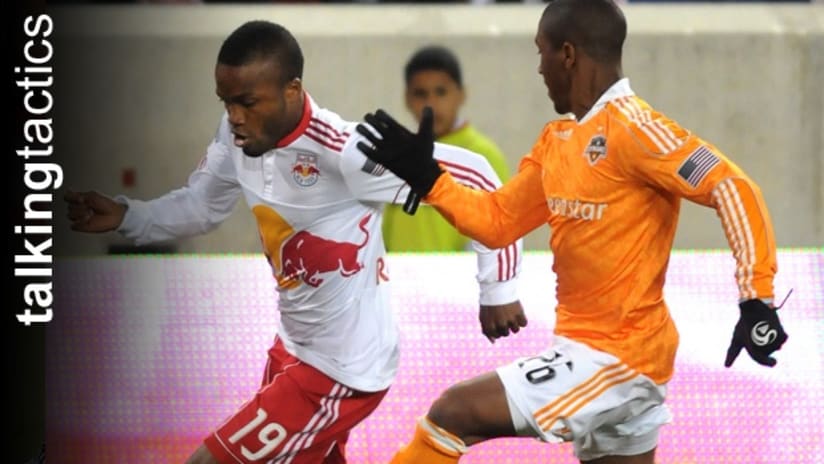A few weeks ago the Houston Dynamo needed an answer for Dane Richards, the New York Red Bulls attacker who has been so destructive to the team from South Texas.
So Dynamo coach Dominic Kinnear took a gamble, asking speedy midfielder Corey Ashe to try his fleet feet at fullback. Left fullback, to be precise, where he could directly oppose Richards.
Mission accomplished. Ashe pretty much neutralized – or at least mitigated – Richards’ speed.
But since not every club has a Corey Ashe, the changes required when dealing with speedy attackers are frequently more in the tactical realm.
Mostly, it’s about proper defensive starting positions and pressure on the ball that can deny service – and also about discipline and awareness in managing those tasks.
Modern defense is all about the four-man zonal marking, of course, a.k.a. the “flat four.” From there, defensive philosophy and personnel dictate where teams draw their defensive lines of restraint. The major variable is whether teams prefer high-pressure or low-pressure defensive tactics.
There are plenty of swift strikers and midfielders in MLS: Richards, Columbus’ Robbie Rogers, Chicago’s Dominic Oduro and either of Dallas’ current pair of frontrunners, Fabian Castillo and Marvin Chavez.
Generally speaking, to stop guys like this, defenses want to “squeeze” the game. That means they press the line as “high” as possible toward the midfield stripe. They’ll go as far up as they believe safe, effectively compressing the space through which attackers may operate.
But there is a danger here, because they run the risk of allowing a speedster to get to a ball over the top or nursed cleverly through the passing lanes. So defenses facing real speed tend to be more cautious, drawing that restraining line a little further back toward their own goal.
Then again, they can’t drop too far back. If they afford too much space in front of them, attackers get time and space to drop and gather the ball. Then defenders face an equally formidable challenge: stopping a fast forward or winger who is running at them with the ball, at full gallop. As proof, just watch how Toronto’s Joao Plata torments a defense when he turns and faces goal with the ball.
So defenders must constantly communicate, moving the line forward and back, depending on what else is happening on the field.
Mostly, they are looking at pressure on the ball. When an opposing midfielder or defender in possession has time to pick his head up and play a long ball behind the defense, it’s time for defenders to start backing up.
The LA Galaxy probably provide the best example of a back line that stays tightly aligned, expertly adjusting forward and backward in a coordinated movement that would make a synchronized swimming team take notice. (They were even better when Gregg Berhalter was on patrol, but they still maintain a fairly aggressive posture now, with the veteran center back unable to reclaim his starting spot.)
Goalkeepers play a big role in defending against speed, too. Goalkeepers comfortable with their feet and capable of venturing away from their goal to deal with those probing balls aimed at fast attackers, provide defenses with a higher level of confidence. That allows the rear guard to set up their line even higher.
Real Salt Lake’s Nick Rimando is a good example here. Quick and brave, he’s never afraid to move out beyond the 18 to intercept balls played over the defense. He also possesses great instincts, knowing which balls he can reach and which he can’t.
Colorado’s Matt Pickens, on the other hand, is not as quick as Rimando, nor does he possess the same instincts. But that doesn’t really matter because Pickens has Marvell Wynne playing at centerback in front of him. Wynne may be the league’s fastest defender, and his ability to chase down anything over the top means Colorado can still be fairly aggressive, drawing the restraining line slightly higher than others. That leaves Pickens to concentrate on his strengths as a very fine shot-stopper.
Generally, dealing with speed requires a defender to keep the action in front of him rather than allowing things to happen in behind. Unless you’ve got Ashe’s speed, or Wynne’s speed, of course. But how many coaches have access to something like that?


